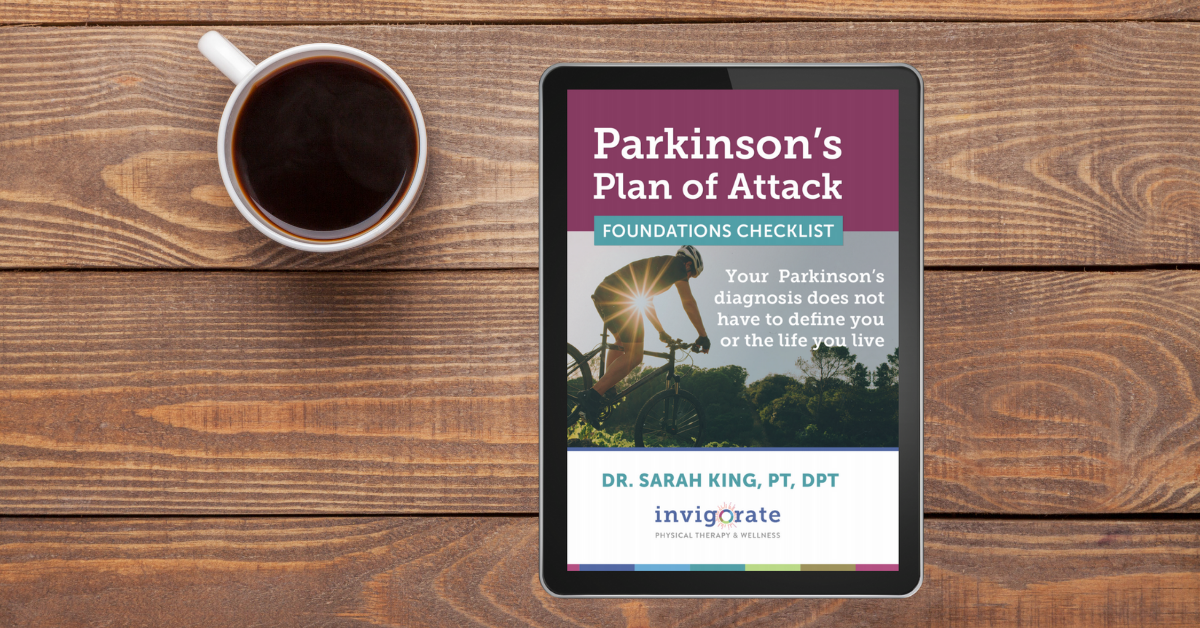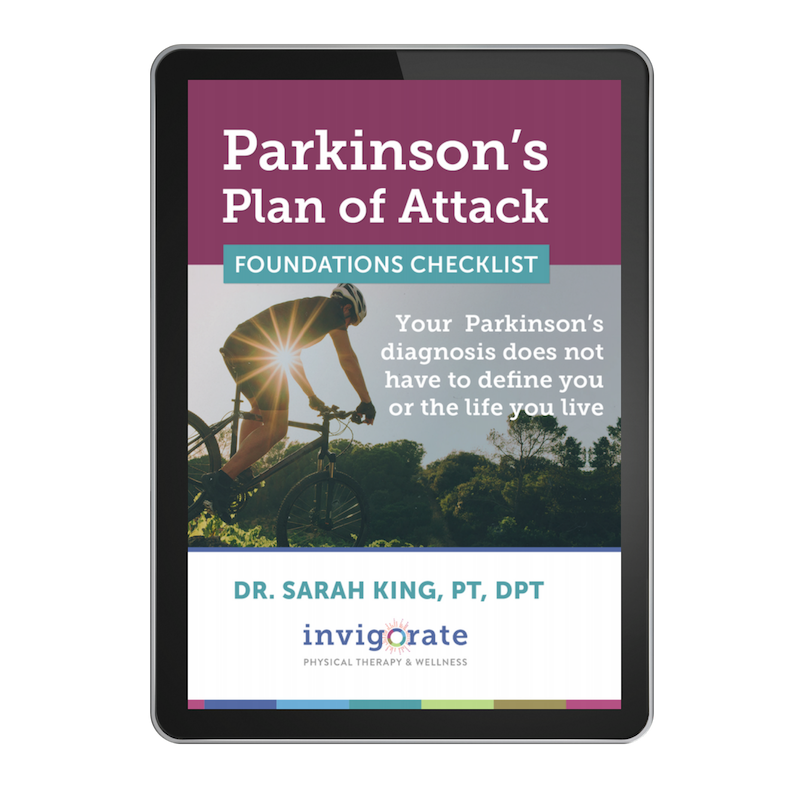My goal has always been to put myself out of business.
One way to do this is to find a cure for Parkinson’s. (That day is coming, no doubt.)
The next best way would be to find an answer for the Apathy and Low-Motivation that can often come as side-dish symptoms of PD.
Let’s be real here: If you were able to motivate yourself and hold yourself accountable to your exercise program you’d likely fire me as your therapist.
I imagine our conversation would go something like this:
“Sarah, I love you. You’re chipper and fun and I think your jokes are hilarious. However, I don’t think I need you anymore because I’m jazzed about my exercise program and I have no problem psyching myself up for my daily workouts. Your job here is done! Au Revoir!”
Unfortunately, this just isn’t the case (except that my jokes are, indeed, hilarious).
So, my doors are staying open which means I’ll continue to arm you with the best weapons I’m aware of to help you find some effective tools to combat those feelings of apathy and low-motivation today and for the days to come.
Let's jump in then, shall we?
Apathy and Motivation: Correlated with Dopamine Levels
Recently I attended a talk by Dr. Anthony Phillips, a professor at The University of British Columbia, who discussed how dopamine levels are correlated with Parkinson’s apathy and motivation:
Dopamine levels rise with the anticipation of a positive reward, and is sensitive to the reward magnitude.
Translation:
So, how can you apply this to your daily life?
Dopamine levels rise with the anticipation of a reward (i.e. achieving your goals), not when you actually achieve them. This means that identifying what you want to accomplish is an incredibly important and potent aspect of maximizing your dopamine levels.
Today I’m going to walk you through how to set one big, meaningful goal that can help pull you out of that apathetic state and motivate you to get (and stay) moving for the long-run.
You can always return to this exercise and set additional goals, but today let’s try to identify your #1 goal for the next 3 months.
1. Brainstorm a Goal
What aspects of your health or fitness do you want to improve?
Here are some I hear often from my clients to start your brainstorming:
Improve your posture
Walk with more confidence
Feel more balanced
Increase your stamina and endurance
Boost your energy
Don’t overthink it. Write down the ONE thing that you feel most drawn to.
2. Give your Goal Meaning
Why did you choose the goal above?
What will achieving that goal open up for you?
After your goal write the connector words: “SO THAT I CAN …” Then, finish the sentence.
Here’s an example:
“I want to increase my stamina and endurance SO THAT I CAN walk around Schlitterbahn water park with my grand-kids for 4 hours this summer.”
3. Give your Goal Magnitude
This is where the magic happens!
Having a goal is important, but the power lies in how potent that goal is for you. You’ll remember that the degree to which dopamine levels rise is sensitive to the magnitude of the reward presented.
Translation: Your goal has to hit a deep chord and resonate with you.
To add Magnitude to your goal, start to channel all the feelings around the goal. How would you feel if you were able to achieve that goal? Let yourself feel the excitement, joy, pride, peace of mind, etc. that would inevitably come with achieving that goal.
Go back to the goal you’ve written and add the connector words “AND FEEL”. Then, fill in 2-3 of the most powerful feelings that surfaced for you.
Using our example from above:
“I want to increase my stamina and endurance SO THAT I CAN walk around Schlitterbahn water park with my grand-kids for 4 hours this summer AND FEEL grateful and confident in my ability to be an active and involved grandmother.”
4. Give your Goal a Measurement
You’ll only be able to track your progress towards a goal if you’re measuring it.
What would be a good way to measure if you’re succeeding at your goal?
I encourage you to take initial measurements, and then reassess your progress every 30 days.
Here are some ways to measure your starting point:
Posture: Take a photo of you against a wall from the front or side
Walking: Take a video from the side looking at your form (arm swing, stride length, etc.)
Balance: How long can you stand on one foot?
Endurance: How long can you walk before having to stop? (minutes or distance)
Energy: Use a subjective survey like the Fatigue Severity Scale found here
Take your initial measurement and write it down under your goal with today’s date. Set a reminder to reassess your progress in 30 days.
Troubleshooting
This activity can seem like a Catch-22. After all, if you’re feeling apathetic and not motivated, it can be a challenge to find something that feels meaningful to you.
If you’re struggling, start by reflecting on a few of these questions:
What are 3 things you enjoyed doing a year ago that you’re not doing now?
What things used to make you laugh? Are you still doing them? Could you do them again? If not, what’s limiting you?
Is there anything you’ve always wanted to do that seems possible, but maybe slightly out of reach now?
Are there any places you’d like to visit? Sights you’d like to see?
Do you have any events coming up that you want to feel or look your best at?
Once you find something that resonates with you, take your answer and use it to go through this goal-setting activity.
Finally, if you’re really struggling with intense feelings of sadness, loneliness, apathy, and isolation, it’s important to reach out to your family and/or healthcare team and let them know how you’re feeling. Just because these feelings can come alongside a Parkinson’s diagnosis, does not mean that you have to endure them alone and “just deal with it”. Please seek out professionals - they can help you find tools to lift that heavy feeling and get you back on track.
BLOG: You’re Not Lazy (and other myths about why you don’t exercise by yourself)
Congratulations - You Have Your Big Goal! Now What?
Once you have a goal, you’re ready to take action!
If you’re already actively seeing a therapist, a personal trainer, or going to a regular exercise class, re-visit your goal before each session to motivate you during your workout. Updating your goals every 3 months can help prevent you from getting stagnant.
Are you looking to get started on a Parkinson’s exercise program but not sure where to start?
Just 2.5 hours of exercise each week (approximately 20 minutes per day) for 30 days can significantly reduce how limited you feel by your Parkinson's symptoms.
I've created a 5-week, Parkinson's specific exercise program to help anyone who needs a little extra nudge to get into an exercise routine and find some momentum.
Learn more about it here: www.InvigoratePT.com/Booster
Now, I’d love to hear from you:
What big, meaningful goal are you setting for the next 3 months to help you combat Parkinson’s apathy?
Share them in the comments section below or over in our private Facebook group, The Invigorated Community. Click here to join (it’s free).
If you know someone who's struggling with apathy and motivation, please share this goal-setting activity with them so that they know they're not alone and have a strategy they can use to get back on track.









